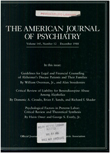Subtype stability in schizophrenia
Abstract
The authors examine the long-term stability of the subtypes of schizophrenia defined by four diagnostic systems. When all patients were considered, agreement between subtype assigned at index and follow- up was modest. This agreement increased considerably when only patients diagnosed as paranoid, hebephrenic, or catatonic at both index and follow-up were considered. As for individual subtypes, stability was highest for paranoid schizophrenia, intermediate for hebephrenia, and virtually absent for undifferentiated schizophrenia. The stability of paranoid schizophrenia was greatest when onset occurred after age 30. As length of follow-up increased, a larger proportion of patients were diagnosed as undifferentiated or residual.
Access content
To read the fulltext, please use one of the options below to sign in or purchase access.- Personal login
- Institutional Login
- Sign in via OpenAthens
- Register for access
-
Please login/register if you wish to pair your device and check access availability.
Not a subscriber?
PsychiatryOnline subscription options offer access to the DSM-5 library, books, journals, CME, and patient resources. This all-in-one virtual library provides psychiatrists and mental health professionals with key resources for diagnosis, treatment, research, and professional development.
Need more help? PsychiatryOnline Customer Service may be reached by emailing [email protected] or by calling 800-368-5777 (in the U.S.) or 703-907-7322 (outside the U.S.).



